MARIANI’S
Virtual
Gourmet
February 27, 2022
NEWSLETTER
ARCHIVE
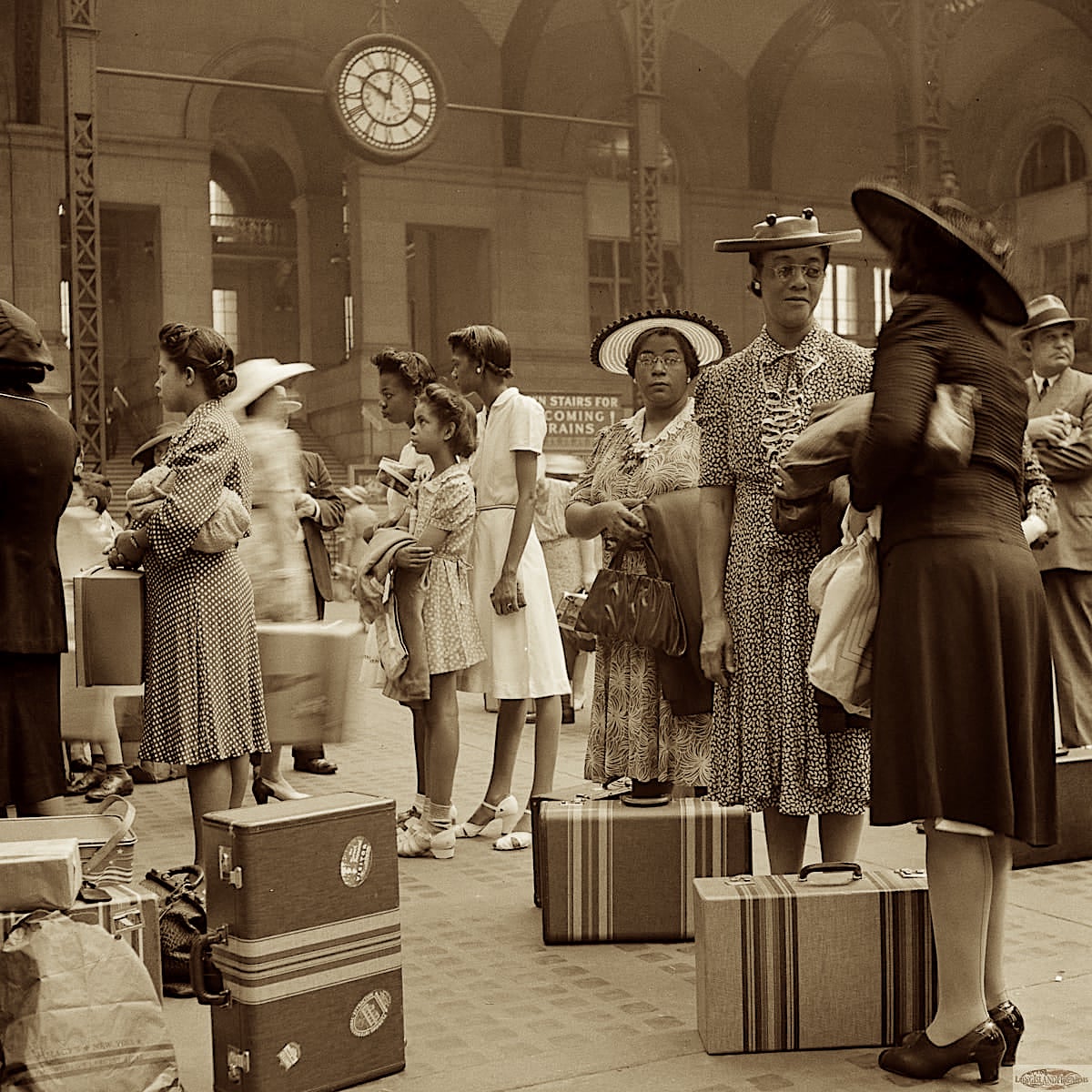
Penn Station, 1942 by Marjorie Collins
IN THIS ISSUE
JAMES BOND'S TASTES:
DIAMONDS ARE FOREVER
By John Mariani
NEW YORK CORNER
BAAZI
By John Mariani
ANOTHER VERMEER
CHAPTER NINE
By John Mariani
NOTES FROM THE WINE CELLAR
AN ARRAY OF NEW RED WINES
IN A RANGE OF PRICES
By John Mariani
❖❖❖
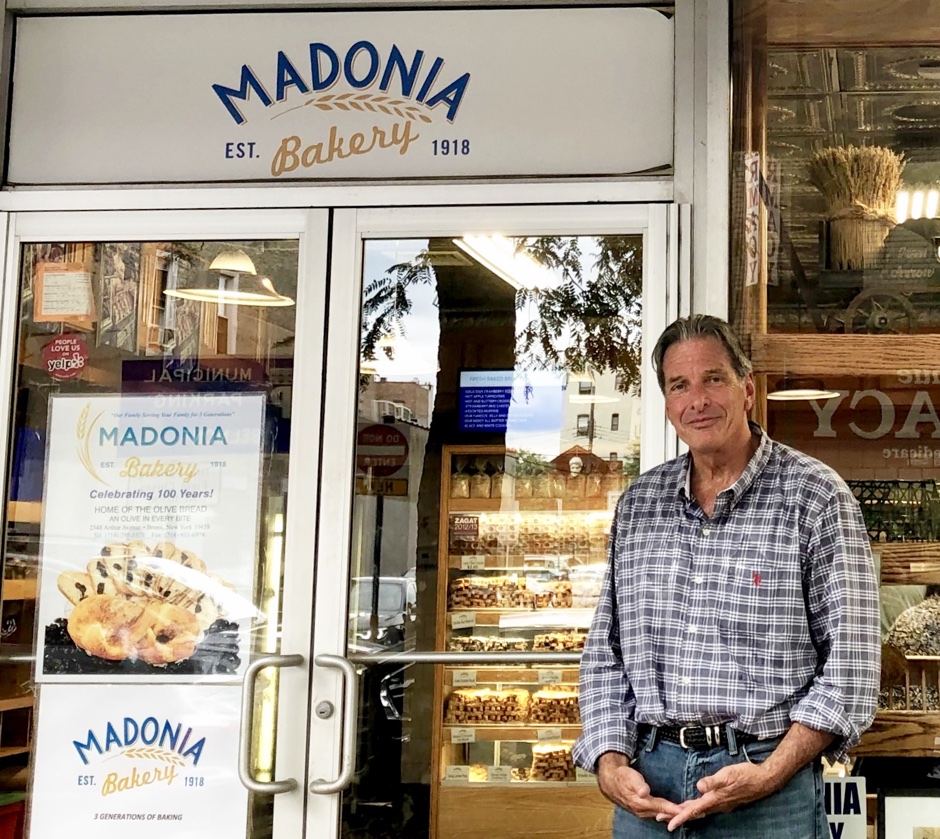 Madonia, formerly CEO of the Chairman of the Belmont Business
Improvement District (BID) owner of the
historic Madonia Bakery on Arthur Avenue
in the Bronx. Go to: WVOX.com.
The episode will also be archived at: almostgolden.
Madonia, formerly CEO of the Chairman of the Belmont Business
Improvement District (BID) owner of the
historic Madonia Bakery on Arthur Avenue
in the Bronx. Go to: WVOX.com.
The episode will also be archived at: almostgolden.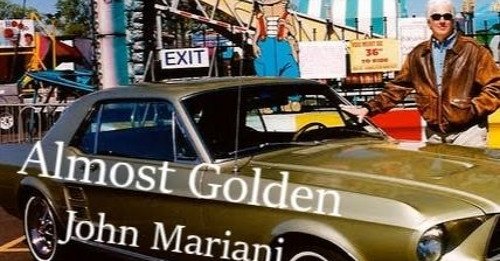
❖❖❖
JAMES BOND'S TASTES,
Part Six:
DIAMONDS ARE FOREVER
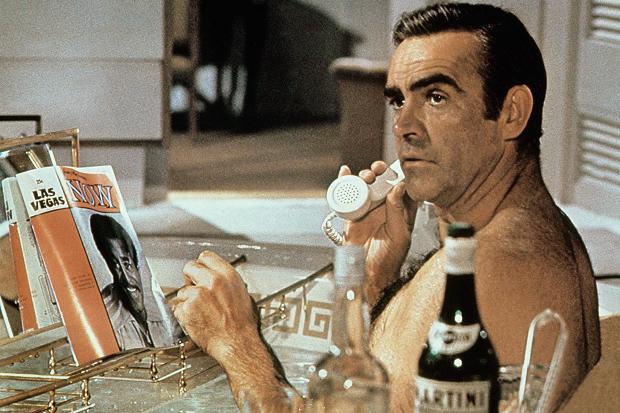
Diamonds Are Forever (1956) was Ian
Fleming’s fourth novel, adapted for the screen
in 1971, starring Sean Connery after he’d left
the series after You Only
Live Twice. Fleming was inspired by a Sunday
Times story about diamond smuggling, and
it gave him the opportunity to send 007 to many
locations where he had a good number of
opportunities to wine and dine.
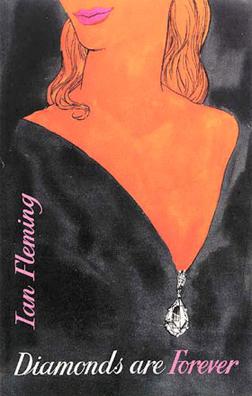 The book’s
plot involves Bond infiltrating the Spangled Mob
smuggling ring in Sierra Leone by impersonating a
smuggler himself. There he meets Tiffany Case, a
gang member whose hatred for all men is due to
being gang raped as a teenager. The action moves
to the U.S. as Bond tracks down Seraffino Spang,
head of the gang, at Saratoga Race Track in
upstate New York, where 007 is told to bet on a
rigged horse race in order to get his fee for
smuggling in diamonds. Afterwards, he travels to
Las Vegas to get his fee, which he obtains in a
The book’s
plot involves Bond infiltrating the Spangled Mob
smuggling ring in Sierra Leone by impersonating a
smuggler himself. There he meets Tiffany Case, a
gang member whose hatred for all men is due to
being gang raped as a teenager. The action moves
to the U.S. as Bond tracks down Seraffino Spang,
head of the gang, at Saratoga Race Track in
upstate New York, where 007 is told to bet on a
rigged horse race in order to get his fee for
smuggling in diamonds. Afterwards, he travels to
Las Vegas to get his fee, which he obtains in a 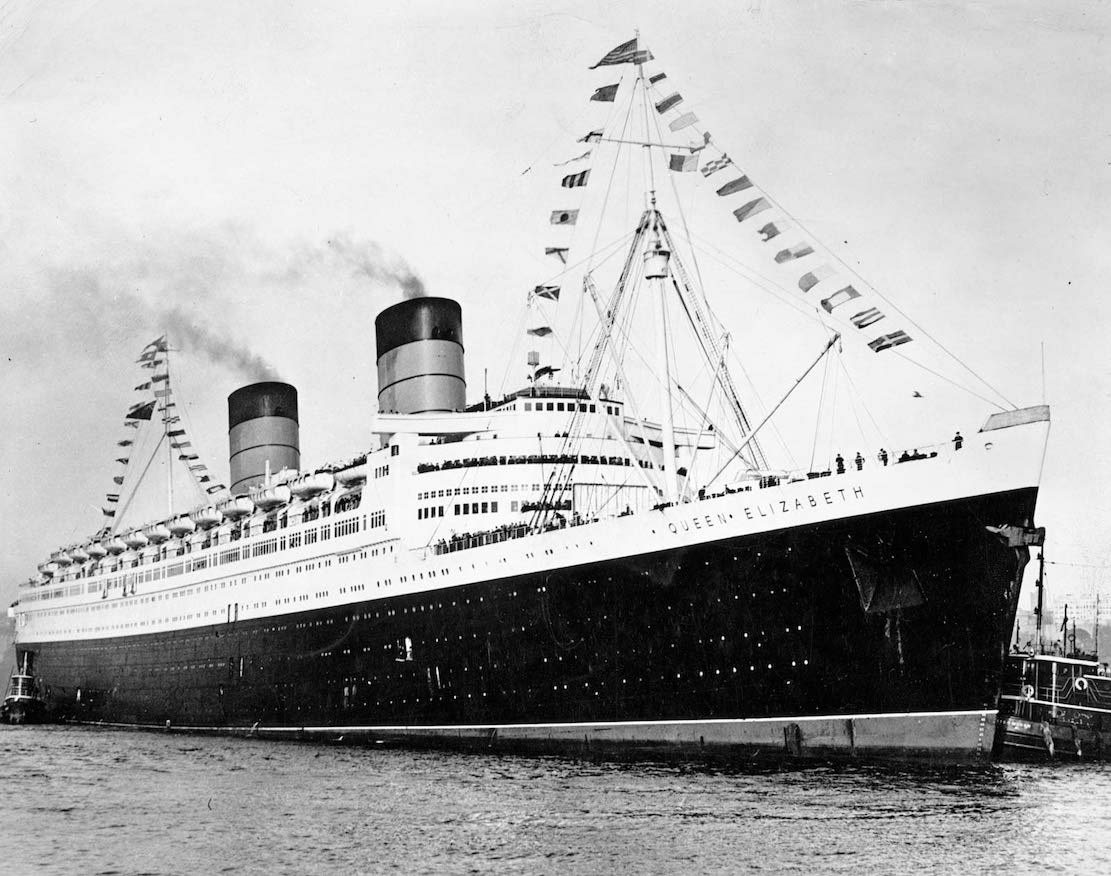 rigged
blackjack game for which Tiffany Case is the
dealer. Spang suspects Bond of being a plant and
kidnaps him, bringing him to his private estate
named Spectreville, where Bond is roughed up
before he can escape on a
railway push-car, with Spang following
on an old Western train. Bond shoots Spang and,
with Tiffany, heads for New York to board the RMS Queen
Elizabeth. Onboard, two Spang thugs, named
Wint and Kidd, seize Tiffany, but Bond rescues her
and kills both gangsters. The story then returns
to Sierra Leone, where Bond shuts down the
diamond-smuggling pipeline and kills Spang in his
helicopter.
rigged
blackjack game for which Tiffany Case is the
dealer. Spang suspects Bond of being a plant and
kidnaps him, bringing him to his private estate
named Spectreville, where Bond is roughed up
before he can escape on a
railway push-car, with Spang following
on an old Western train. Bond shoots Spang and,
with Tiffany, heads for New York to board the RMS Queen
Elizabeth. Onboard, two Spang thugs, named
Wint and Kidd, seize Tiffany, but Bond rescues her
and kills both gangsters. The story then returns
to Sierra Leone, where Bond shuts down the
diamond-smuggling pipeline and kills Spang in his
helicopter.
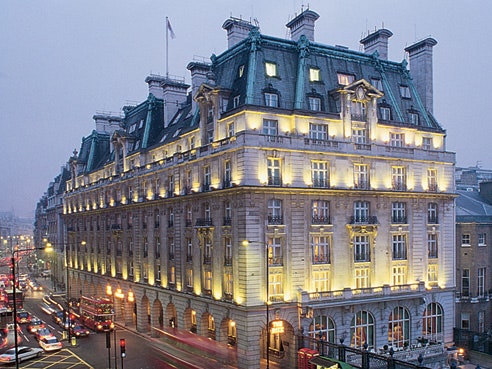 At
the beginning of the story, Bond is staying at The Ritz
(left) in London and takes his MI6
colleague Bill Tanner for a lunch of dressed crab
and a “pint of black velvet” at Fleming’s favorite
restaurant, Scott’s. The
pint of black velvet is not the brand of whiskey
by that name but a mix of stout, ale and
Champagne.
At
the beginning of the story, Bond is staying at The Ritz
(left) in London and takes his MI6
colleague Bill Tanner for a lunch of dressed crab
and a “pint of black velvet” at Fleming’s favorite
restaurant, Scott’s. The
pint of black velvet is not the brand of whiskey
by that name but a mix of stout, ale and
Champagne. 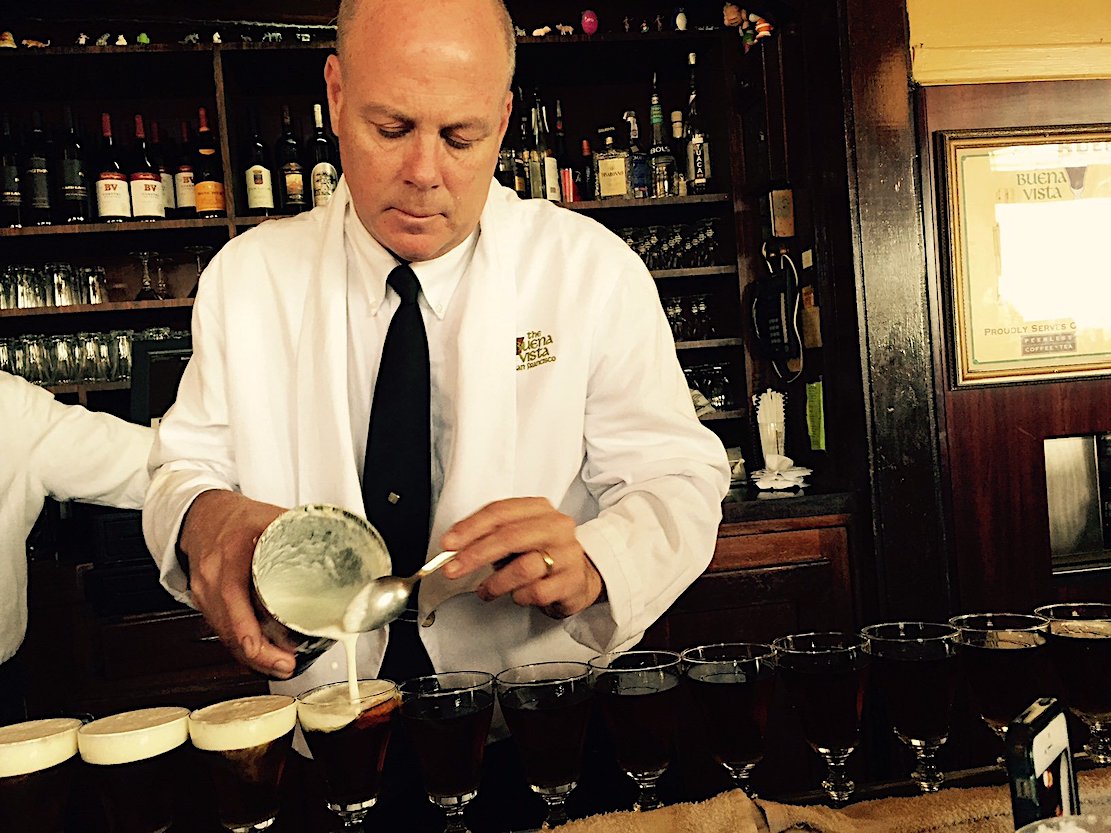
While waiting to board his BOAC flight to
New York from Shannon Airport in Ireland, Bond
enjoys a steak and Champagne dinner, ending of
with Irish coffee, a drink that originated at Foynes Dock,
where during the war the seaplanes took off from.
The concoction was created by chef Joe Sheridan in
1942 and featured as a promotion for Irish whiskey
at Shannon as of 1947. It was introduced to the
U.S. in 1952 at San Francisco’s Buena Vista Bar.
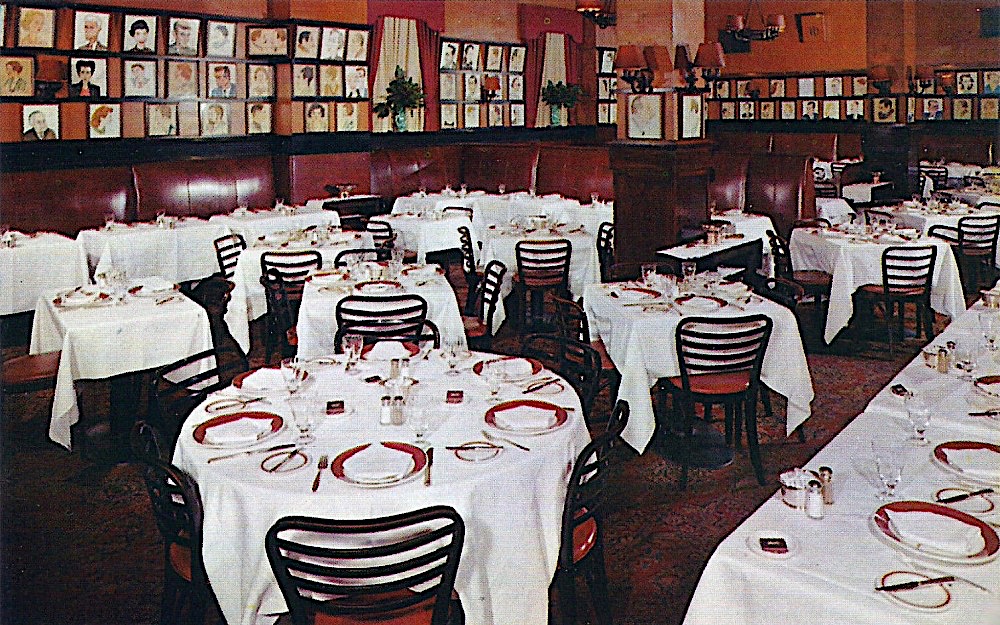 In New York Bond dines upstairs with Felix
Leiter at the Theater District restaurant Sardi’s (left),
ordering martinis and Nova Scotia salmon that
Fleming calls “a poor substitute for the product
from Scotland,” followed by “brizzola” (braciola,
Italian beef rolls) made with a California
vermouth (“best I’ve ever tasted,” says Bond) and
half a dressed avocado and espresso. The next day
over lunch at
In New York Bond dines upstairs with Felix
Leiter at the Theater District restaurant Sardi’s (left),
ordering martinis and Nova Scotia salmon that
Fleming calls “a poor substitute for the product
from Scotland,” followed by “brizzola” (braciola,
Italian beef rolls) made with a California
vermouth (“best I’ve ever tasted,” says Bond) and
half a dressed avocado and espresso. The next day
over lunch at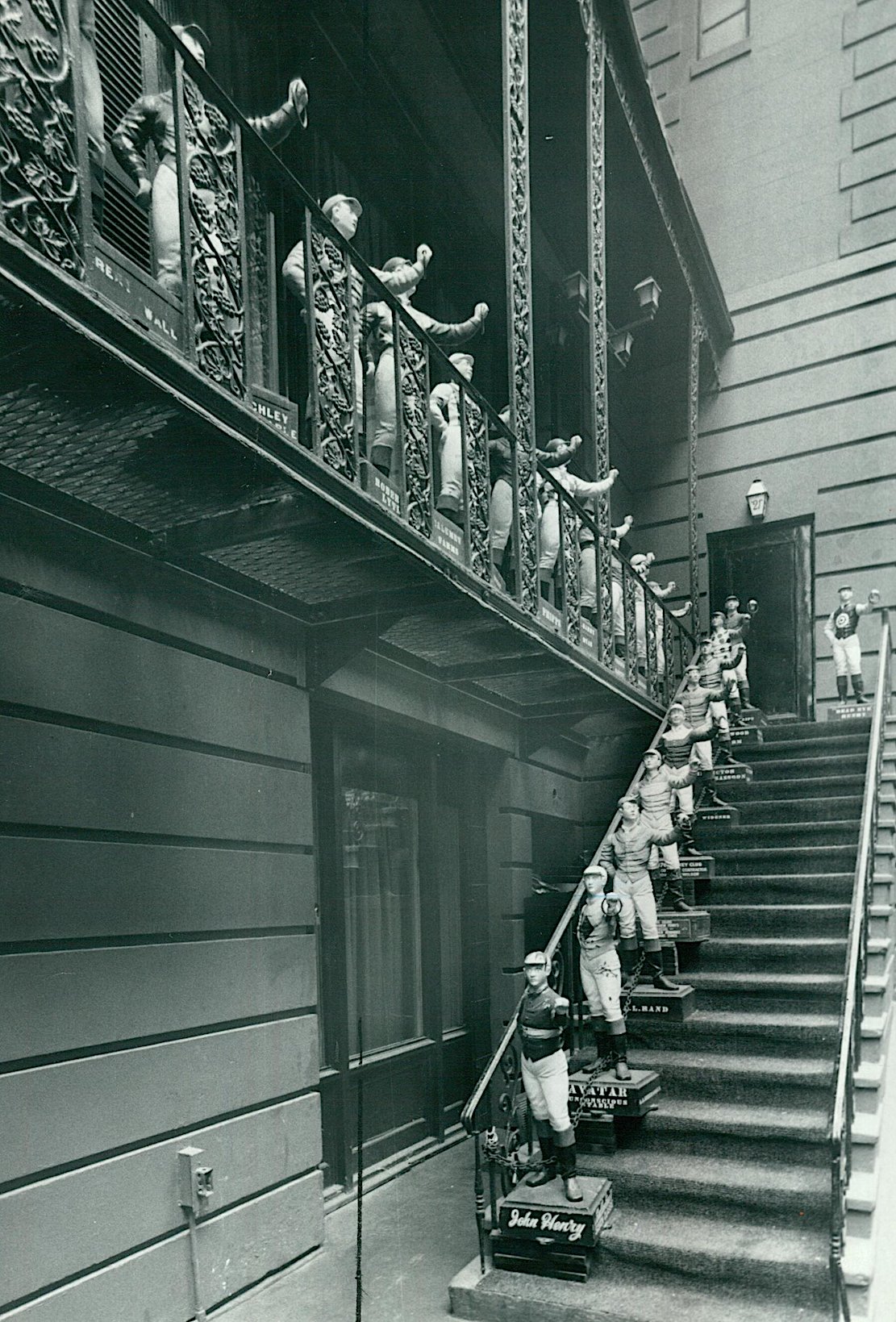 ‘21’ Club
(right) on West 52nd Street, Tiffany tells
him she won’t sleep with him, saying, “It’s going
to take more than Crabmeat Ravigote to get me into
bed. In
any case, since it’s your check, I’m going to have
the caviar and what you English call cutlets and
some pink champagne.” The Champagne is a rosé
Veuve Clicquot, which they enjoy with the veal
cutlets, asparagus with sauce mousseline and white
stingers (Cognac and white crème de menthe, potent
cocktail that seems wholly out of place with
dinner).
‘21’ Club
(right) on West 52nd Street, Tiffany tells
him she won’t sleep with him, saying, “It’s going
to take more than Crabmeat Ravigote to get me into
bed. In
any case, since it’s your check, I’m going to have
the caviar and what you English call cutlets and
some pink champagne.” The Champagne is a rosé
Veuve Clicquot, which they enjoy with the veal
cutlets, asparagus with sauce mousseline and white
stingers (Cognac and white crème de menthe, potent
cocktail that seems wholly out of place with
dinner).
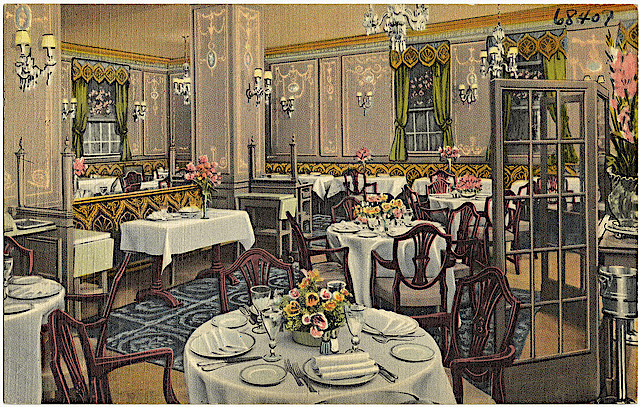 The real life
partner-owner of the restaurant, Pete Kriendler,
who with his brother and Charlie Berns had opened
‘21’ during Prohibition, comes over to greet
Tiffany as a regular, and she quips that his
“little hot-dog stand isn’t doing too badly.”
Tiffany does in fact pick up the check,
inexplicably, but won’t renege on her promise to
stay out of Bond’s bed, later telling him she has
never slept with a man after the gang rape
incident. The next day Bond dines alone at Voisin (above)
on Park Avenue, then one of New York’s most
luxurious French-Viennese restaurants, ordering
two
The real life
partner-owner of the restaurant, Pete Kriendler,
who with his brother and Charlie Berns had opened
‘21’ during Prohibition, comes over to greet
Tiffany as a regular, and she quips that his
“little hot-dog stand isn’t doing too badly.”
Tiffany does in fact pick up the check,
inexplicably, but won’t renege on her promise to
stay out of Bond’s bed, later telling him she has
never slept with a man after the gang rape
incident. The next day Bond dines alone at Voisin (above)
on Park Avenue, then one of New York’s most
luxurious French-Viennese restaurants, ordering
two vodka martinis, eggs Benedict and
strawberries.
vodka martinis, eggs Benedict and
strawberries.
In the
next chapter Bond leaves with Leiter for Saratoga,
stopping along the way for a lunch at Chicken in
the Basket on the Taconic Parkway, avoiding the
“fresh mountain trout” that “had spent months in
some distant deep-freeze,” instead ordering
scrambled eggs with rye toast and iced coffee. In
Saratoga he checks into the Sagamore Hotel, based
on the original Pavilion Hotel (right),
built in 1819, which was the most opulent of its
time. (There is a Sagamore Resort on Lake George,
but it is 60 miles from Saratoga Springs.) Bond
takes a walk through town and drops into a local
spot for two bourbons and a $4.50 fried chicken
dinner. That evening he joins Felix at the
Pavilion restaurant in the hotel for a meal of
lobsters 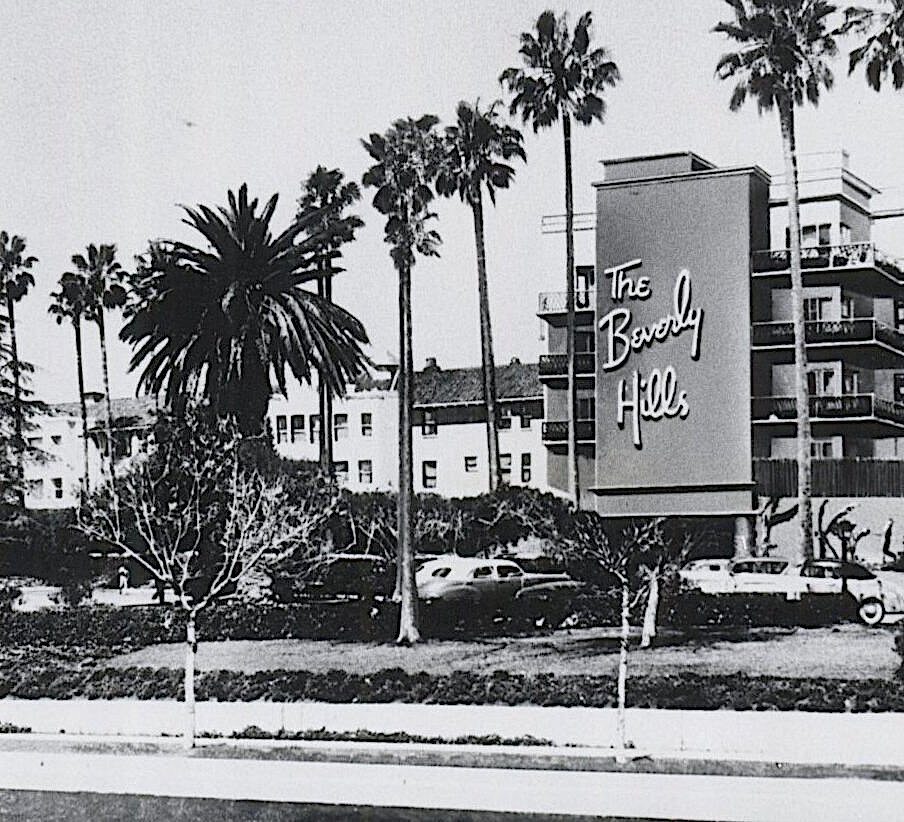 and
martinis made with Cresta Blanca white vermouth.
Bond also orders a bourbon with “branch water,”
supposedly very pure water from a stream, which
Bond notes is not going to be available in Las
Vegas (although later a Vegas barman assures him
he flies in branch water regularly from Boulder
Dam!)
and
martinis made with Cresta Blanca white vermouth.
Bond also orders a bourbon with “branch water,”
supposedly very pure water from a stream, which
Bond notes is not going to be available in Las
Vegas (although later a Vegas barman assures him
he flies in branch water regularly from Boulder
Dam!)
When the action shifts to Vegas, 007 checks
into the fictitious Tiara Hotel, ordering poolside
a plate of cherrystone clams and a steak. After
his escape with Tiffany from Spang, they head for
the Beverly
Hills Hotel (left), the
famous “Pink Palace” opened in 1912 for Hollywood
industry stars and filmmakers, but they soon must
leave for the airport to fly overnight
on a Trans-World Airlines Super-G Constellation,
Flight 93._JP5987162.jpeg) Upon arriving in New York, they happily
board the “great safe black belly” of the Queen
Elizabeth.
Upon arriving in New York, they happily
board the “great safe black belly” of the Queen
Elizabeth.
Tiffany suffers from sea sickness, but on
the third night out, Bond meets her for martinis
at the Observation Ba (below),
and they plan to dine at the 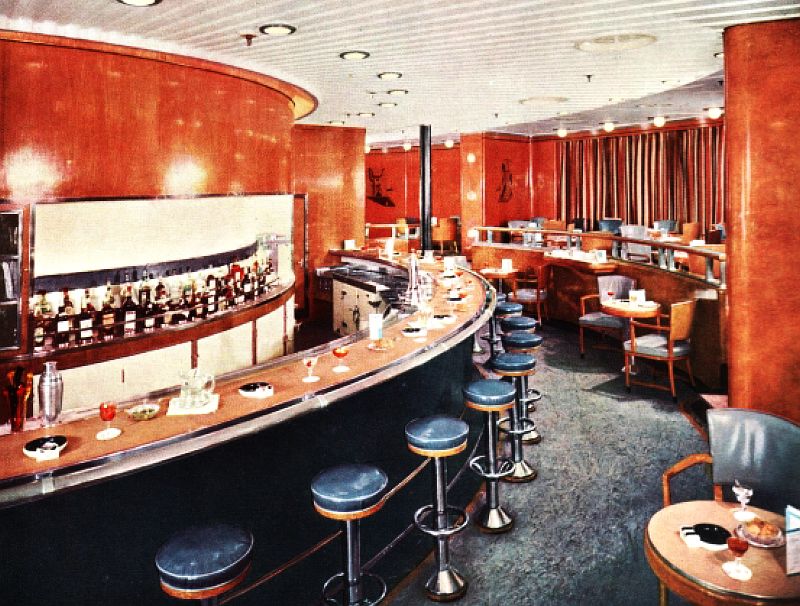 Verandah
Grill. She still insists the Englishman is after
“her family jewels,” as they sip vodka martinis,
and she asks, “tell me what sort of woman you
think would add to you.” Bond responds, “Somebody
who can make sauce Béarnaise as well as make
love,” causing her to ask him to take her to her
stateroom. Bond returns to his cabin, there is a
knock at the door, and a waiter brings in a
quarter-bottle of Bollinger Champagne, a chafing
dish with four slices of beef on toast, a small
bowl of sauce Béarnaise and a note reading, “This
sauce Béarnaise has just been created by Miss T.
Case without any assistance from me. Signed, The
Chef.”
Verandah
Grill. She still insists the Englishman is after
“her family jewels,” as they sip vodka martinis,
and she asks, “tell me what sort of woman you
think would add to you.” Bond responds, “Somebody
who can make sauce Béarnaise as well as make
love,” causing her to ask him to take her to her
stateroom. Bond returns to his cabin, there is a
knock at the door, and a waiter brings in a
quarter-bottle of Bollinger Champagne, a chafing
dish with four slices of beef on toast, a small
bowl of sauce Béarnaise and a note reading, “This
sauce Béarnaise has just been created by Miss T.
Case without any assistance from me. Signed, The
Chef.”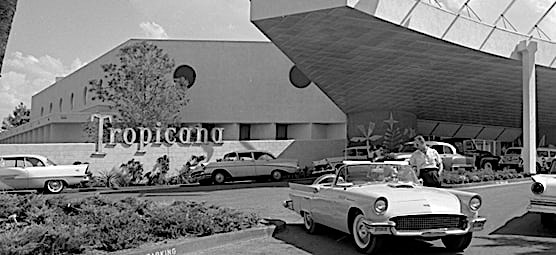
Location-wise, Bond in the movie meets
hustler Plenty O’Toole at the Whyte House,
owned by the character Willard Whyte, in the
movie played by Jimmy Dean, (filmed at The
Riviera, though the hotel façade was actually
the Las Vegas International Hotel, later the
Hilton). Plenty ends up thrown into the pool
below Bond’s suite by three henchmen. Bond
was staying at The Tropicana but then moves to
Tiffany’s suite at the
Whyte House.
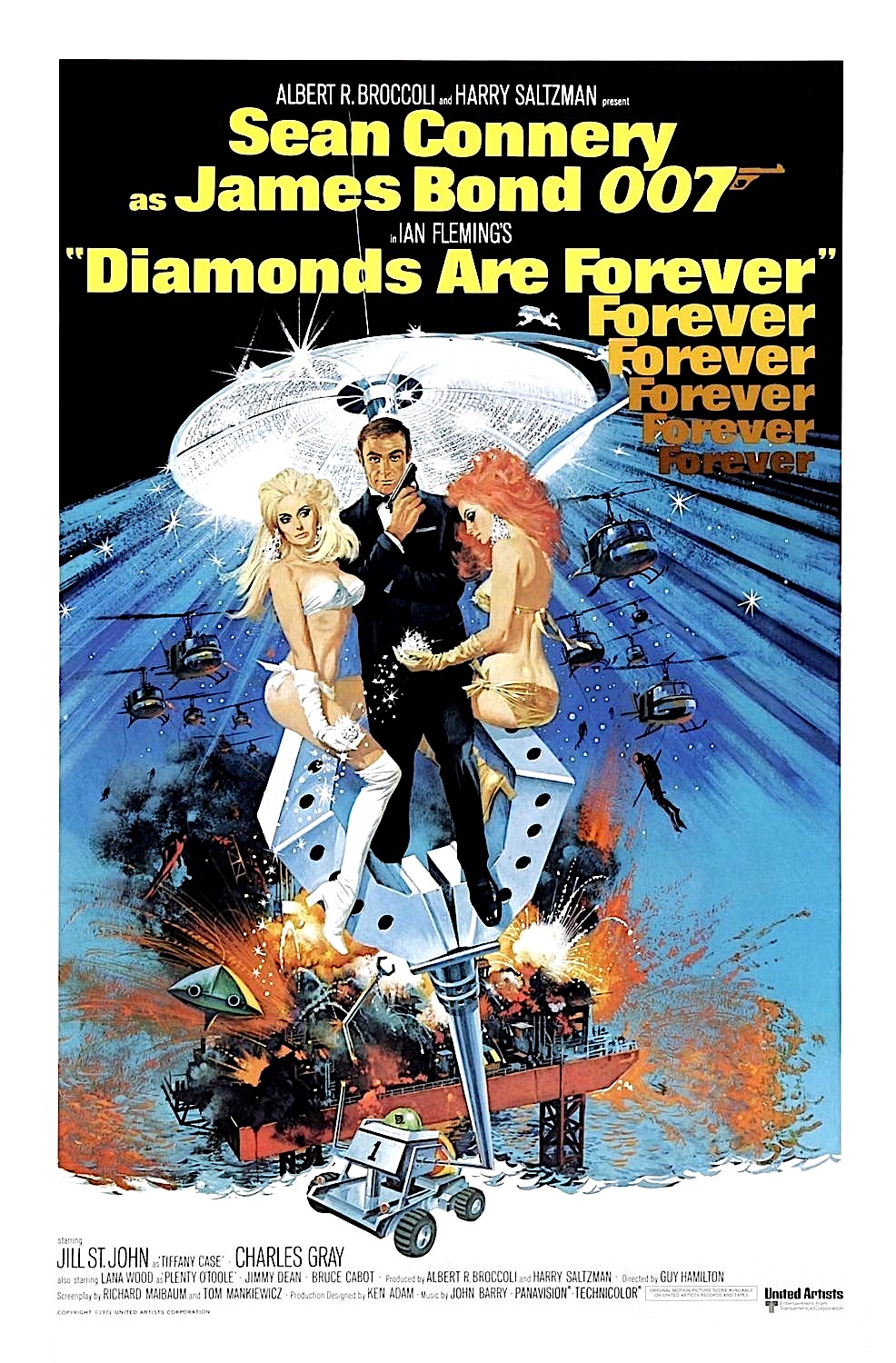
There is nothing close to the
number of food and drink mentions in the 1971
movie of Diamonds
Are Forever, whose plot line differs
radically from the novel’s and occurs in 1970,
with references to the Apollo moon landing. There
are, though, three important incidents in the film
involving Bond’s knowledge of wine.
 In the first, 007 is meeting with his boss
M and Sir Donald Munger to discuss the South
African smuggling operations. Munger hands Bond a
glass of Sherry, but M refuses for “health
reasons.” Bond sniffs the Sherry (above)
and says, “Too bad about your liver, sir. It’s an
unusually fine Solera, ‘51, I think.” M snorts,
“There are no years for
Sherry, 007,” to which Bond replies, “I was
speaking about the original Sherry on which it is
based . . . 1851.” Bond’s snarky remark refers to
the fact that Sherries are made from a blend of
various batches from a harvest’s barrels stacked
in tiers, to be blended with other, older wines.
So, Bond is referring to the harvest of 1851, a
brandishing of
In the first, 007 is meeting with his boss
M and Sir Donald Munger to discuss the South
African smuggling operations. Munger hands Bond a
glass of Sherry, but M refuses for “health
reasons.” Bond sniffs the Sherry (above)
and says, “Too bad about your liver, sir. It’s an
unusually fine Solera, ‘51, I think.” M snorts,
“There are no years for
Sherry, 007,” to which Bond replies, “I was
speaking about the original Sherry on which it is
based . . . 1851.” Bond’s snarky remark refers to
the fact that Sherries are made from a blend of
various batches from a harvest’s barrels stacked
in tiers, to be blended with other, older wines.
So, Bond is referring to the harvest of 1851, a
brandishing of 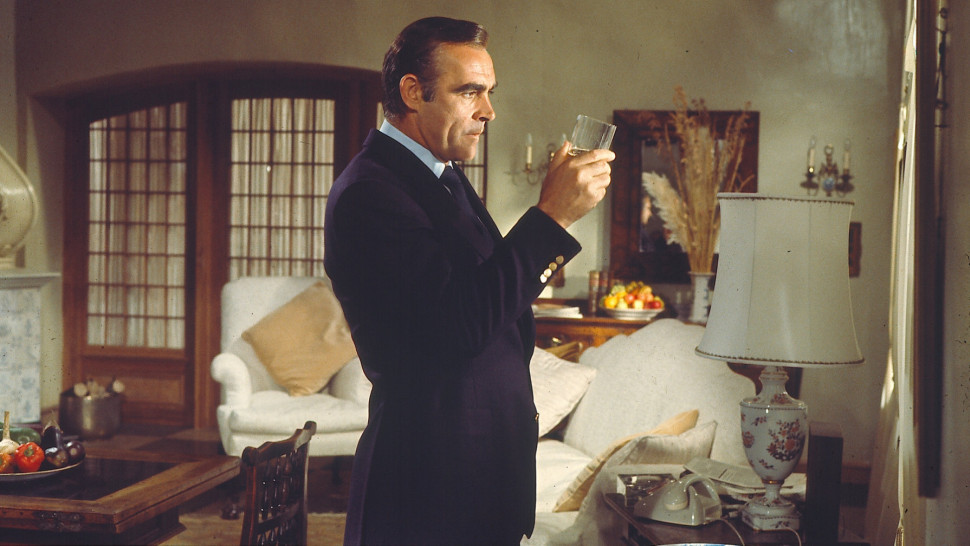 his
connoisseurship nearly impossible for anyone, even
in the Sherry trade, to match.
his
connoisseurship nearly impossible for anyone, even
in the Sherry trade, to match.
The second instance is when Bond, posing as
a smuggler, visits Tiffany (Jill St. John) in her
flat in Amsterdam, impersonating a smuggler she’s
expecting. Tiffany invites him to pour himself a
drink, and after he does so, she takes his glass
and says, “I’ll get you some ice,” then out of
sight dusts it for fingerprints, not knowing that
he 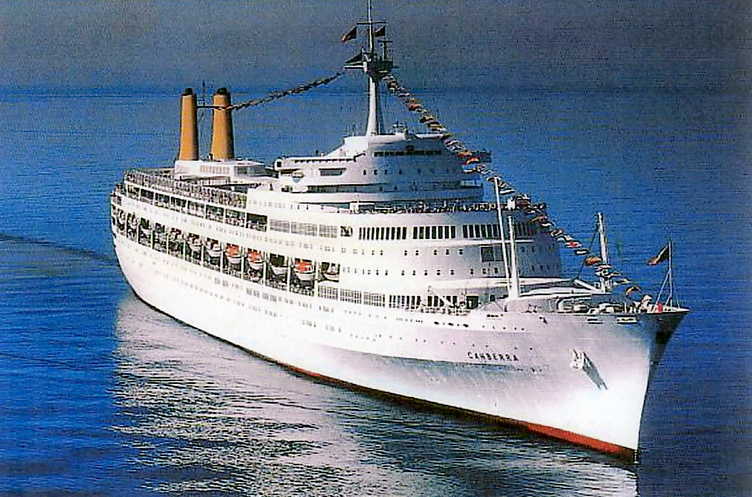 has replicated
the man whose identity he has assumed with thin
plastic adhesives of his fingerprints provided by
his faithful MI6 inventor, Q (above).
has replicated
the man whose identity he has assumed with thin
plastic adhesives of his fingerprints provided by
his faithful MI6 inventor, Q (above).
The
last
occurred while crossing the Atlantic—not on the Elizabeth,
which had been taken out of service in 1968, but
on the S.S.
Canberra (left),
which went into service in 1960 (and later served
as a troop ship in the Falklands War of 1982). Two
of Spang’s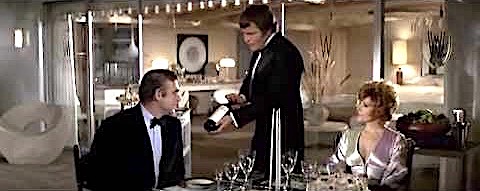 henchmen pose
as waiters delivering Bond’s dinner of oysters Andaluz
(fried with green chilies and chorizo), “tidbits
of beef” shashlik on burning skewers, breadsticks,
Courvoisier Cognac, wine and a bombe
surprise, which is, of course, an actual
bomb.
henchmen pose
as waiters delivering Bond’s dinner of oysters Andaluz
(fried with green chilies and chorizo), “tidbits
of beef” shashlik on burning skewers, breadsticks,
Courvoisier Cognac, wine and a bombe
surprise, which is, of course, an actual
bomb.
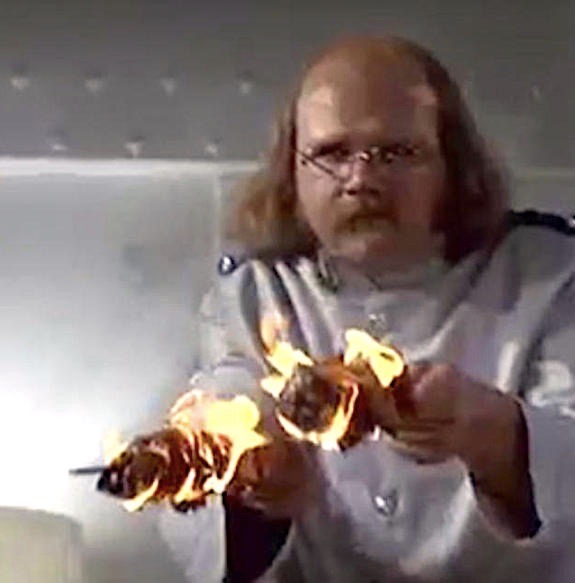 Suspicious
of the two men, Bond inspects the wine bottle
label, a Mouton-Rothschild (above), and
says nonchalantly, “Hmm, for such a grand meal I
rather expected a claret,” which is the British
term for a red Bordeaux. The villain replies,
“Unfortunately our cellar is poorly stocked with
clarets.” Bond says, “But Mouton-Rothschild is a
claret,” exposing the man on the assumption that a
wine steward on a luxury liner would never make
such a fundamental mistake, adding, “and I’ve
smelled that aftershave twice before, and both
times I smelled a rat.”
Suspicious
of the two men, Bond inspects the wine bottle
label, a Mouton-Rothschild (above), and
says nonchalantly, “Hmm, for such a grand meal I
rather expected a claret,” which is the British
term for a red Bordeaux. The villain replies,
“Unfortunately our cellar is poorly stocked with
clarets.” Bond says, “But Mouton-Rothschild is a
claret,” exposing the man on the assumption that a
wine steward on a luxury liner would never make
such a fundamental mistake, adding, “and I’ve
smelled that aftershave twice before, and both
times I smelled a rat.”
The two villains attack Bond.
One comes at him with the burning shashlik
skewers; Bond smashes the bottle of Cognac and
throws the contents at him, causing the man to
burst into flames. The other man Bond flips over
the side of the ship, with the bomb between the
man’s legs. Bond watches the bomb explode and
quips, "Well, he certainly left with his tail
between his legs."
❖❖❖
NEW YORK CORNER
BAAZI
646-861-3859
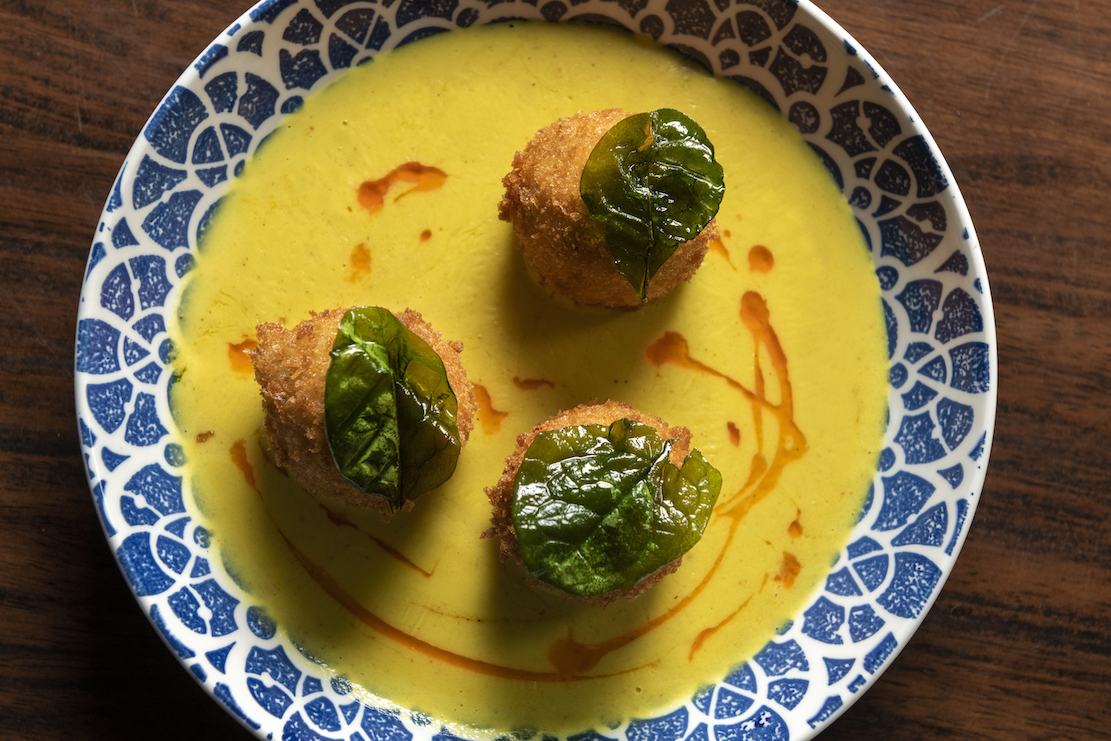
By John Mariani
Photos by Evan Sung
I’m not
sure why
there is such a current uptick in the number
of fine new Indian restaurants around town and
outside of the traditional Indian
neighborhoods like Jackson Heights and Curry
Hill, but I could hardly be happier to find
them showing more and more regional and
contemporary flair than in the past. Baazi,
meaning “bet” in Hindi (as well as the name of
a Bollywood action movie), is a significant
entry and a departure, which is what I’ve come
to expect from chef/owner Gaurav Anand (left),
who for the past dozen years has opened a slew
of restaurants both here and in New Delhi and
Goa. In New York they have included Bhatti
Indian Grill, Awadh and Moti Mahal Deluxe
(which still does the best butter chicken
anywhere).
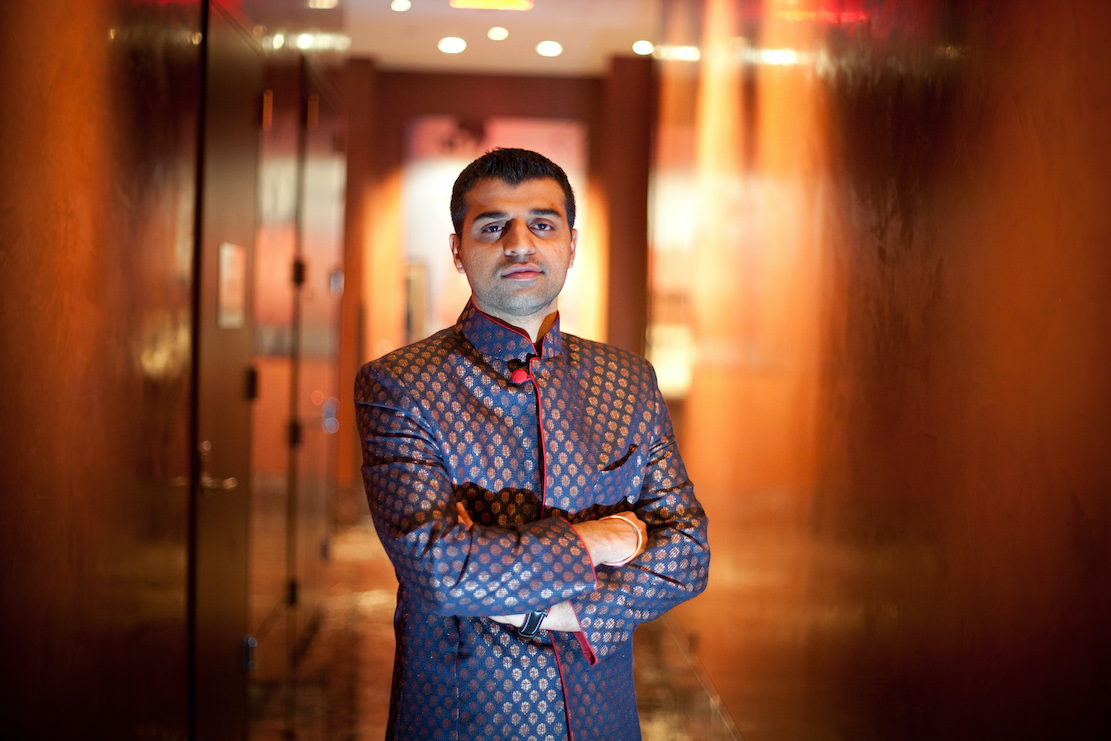 Anand is an ebullient fellow, bounding from
the kitchen to the front door (there is outside
dining) and from table to table, genially assisted
by the engaging and lovely general manager Abla
Atoubi. Baazi is set on two levels in a motif of
royal blue and daffodil yellow, with a live olive
tree inside and a wall of flowers. The bar is a
smart place for Upper West Siders to meet, and,
for once, I actually enjoyed the spiced-up
cocktails, like the Old Monk Daiquiri with
Old Monk 7-year aged Indian rum, pomegranate,
lime, and a Spicy Ginger Margarita.
Anand is an ebullient fellow, bounding from
the kitchen to the front door (there is outside
dining) and from table to table, genially assisted
by the engaging and lovely general manager Abla
Atoubi. Baazi is set on two levels in a motif of
royal blue and daffodil yellow, with a live olive
tree inside and a wall of flowers. The bar is a
smart place for Upper West Siders to meet, and,
for once, I actually enjoyed the spiced-up
cocktails, like the Old Monk Daiquiri with
Old Monk 7-year aged Indian rum, pomegranate,
lime, and a Spicy Ginger Margarita.
The size of the menu makes perfect sense,
just as the size of old-line Indian restaurants’
do not, filled 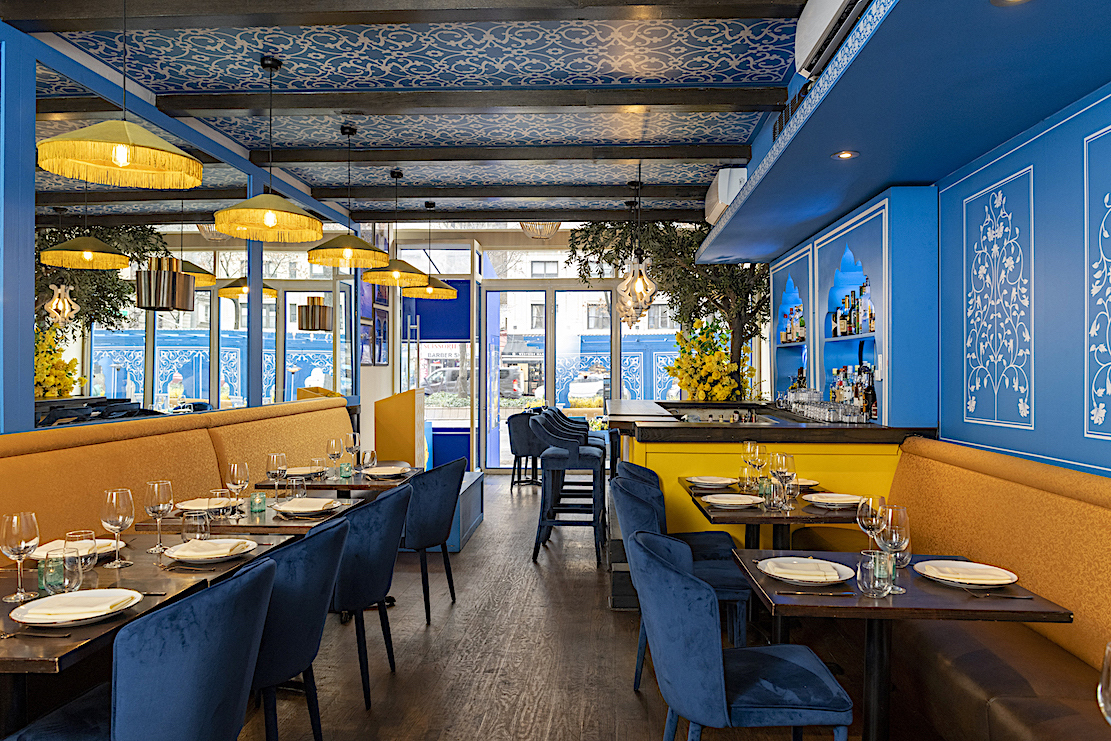 with
columns
of dishes offering beef, lamb, chicken or shrimp
cooked up in the same five sauces. At Baazi you
find what you do not elsewhere, so the number of
dishes—12 appetizers ($15-$26) and an equal number
of main courses ($22-$29), all easy enough to
share and to allow the kitchen to take the time
focusing on their individuality.
with
columns
of dishes offering beef, lamb, chicken or shrimp
cooked up in the same five sauces. At Baazi you
find what you do not elsewhere, so the number of
dishes—12 appetizers ($15-$26) and an equal number
of main courses ($22-$29), all easy enough to
share and to allow the kitchen to take the time
focusing on their individuality.
Peruse the menu and you’ll
find dishes wholly new to New York, beginning with
kali kachori ($15), a snack dish from Uttar
Pradesh, made
with a charcoal cracker plumped up as moist lentil
dumplings, along with chickpeas with aromatic
mint, thick yogurt and pomegranate pearls. Shakarkandi
($15) has nothing to do with the “Sharknado” comedies or
candy: it is a chaat dish of crispy yams
and fingerling potatoes dusted with chili lime and
a sweet sour tamarind emulsion. If you like Indian
paneer cheese dishes the ke sholey
($15) is a form of bread roll made with house made
cottage cheese stuffed with raisins and a more
cheese that is grilled. Papad kebab ($15)
is presented in an elegant wooden box as a
bite-size morsel of lentil cracker crusted with
tangy Greek yogurt and a saffron aïoli.
%20by%20Evan%20Sung.jpg) The
only way I like to eat cauliflower is at Indian
restaurants as aloo gobi ($16), a
classic vegetarian dish at Baazi served with a
sweet coating and onion seeds. Chicken cafreal
($19), whose origins in Goa derive from
Portuguese merchants, is quite hearty for an
appetizer, made with juicy Cornish hen marinated
in mint and coriander. So, too,
the lamb ribs ($26) are delectably glazed with a
sticky sweet tamarind-based sauce and the surprise
of a
The
only way I like to eat cauliflower is at Indian
restaurants as aloo gobi ($16), a
classic vegetarian dish at Baazi served with a
sweet coating and onion seeds. Chicken cafreal
($19), whose origins in Goa derive from
Portuguese merchants, is quite hearty for an
appetizer, made with juicy Cornish hen marinated
in mint and coriander. So, too,
the lamb ribs ($26) are delectably glazed with a
sticky sweet tamarind-based sauce and the surprise
of a 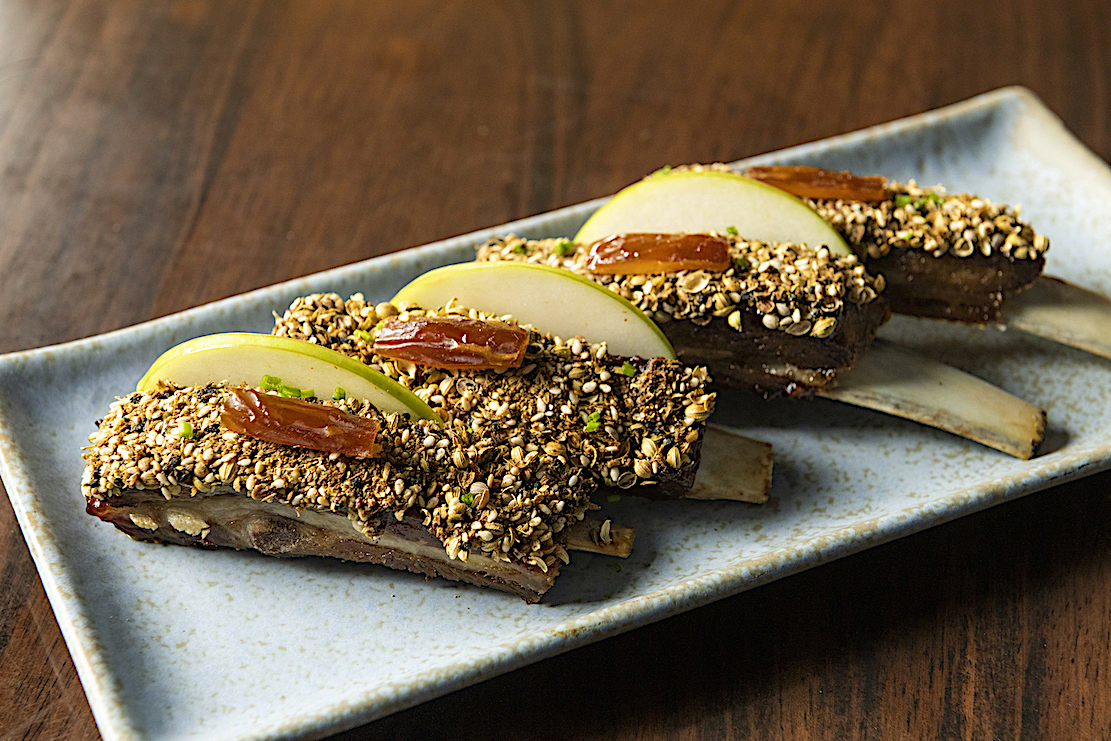 coriander-sesame
crunch (below). There are of course meat
kebabs, here minced lamb patties breaded with papadum
cracker crumbs with Greek tzatziki yogurt,
pickle onions and the Tamil Nadu street bread paratha
($20).
coriander-sesame
crunch (below). There are of course meat
kebabs, here minced lamb patties breaded with papadum
cracker crumbs with Greek tzatziki yogurt,
pickle onions and the Tamil Nadu street bread paratha
($20).
Although popular in India, you don’t expect
to find cod (rohu) on an Indian menu in New
York, but here it is as koliwada ($22), a
Mumbai specialty of beautiful, succulent white cod
with a salty and crispy okra and tartar sauce,
while shrimp balchou (below) is
another Goan dish of pan-seared prawn with a
very spicy, hot with chili pickle ($22).
Anand
does a vegetarian twist on butter chicken with his
butter kala ($16) made with mushrooms and
chickpeas. Butternut
squash
kofta with sweet corn curry, toasted pepitas
and pumpkin oil ($16) is a gorgeous dish and will
persuade any carnivore of the unique excellence of
Indian vegetable curries.
 Onion kulcha ($5) with whole wheat
flour makes for a good side dish, and the basmati
rice ($4) is flavored with lemon.
Onion kulcha ($5) with whole wheat
flour makes for a good side dish, and the basmati
rice ($4) is flavored with lemon.
Desserts, too, are far from the usual
Indian sweets: a jalebi sandwich is a
turn on the pastry funnel cake here with masala
chai ice cream; Coconut sago payasam
is a luscious dish of shaved roasted coconut, soft
tapioca pearls, honey and served with mango
sorbet.
Baazi’s food by any name would be
exciting, and as Indian food goes in New York
Anand is expanding the palette of the myriad
styles of cuisine in the South with color, dash
and tantalizing aromas, all served with
exceptional grace.
Open
nightly
for dinner.
Note: NYC Health Dept. rules require both staff and guests 12 or older to show proof they have received at least one dose of a COVID-19 vaccine.
❖❖❖
ANOTHER VERMEER

To read previous chapters of ANOTHER VERMEER, go to the archive

Just
as Katie had predicted,
Alan
Dobell readily agreed to
the Vegas
trip—without even
reminding her
of the ‘long
leash’ he’d
put her on, saying,
“I wouldn’t
mind, though, if you
did get
an interview with a
casino owner
like Wynn as to
what he thinks
this ‘new’ Las
Vegas is going
to look like.”
Katie thanked him
and, as she left the
office, Dobell said, “And
I’m not paying for that
cop friend of yours to
play blackjack out there.”
“What about my
Bingo cards?”
“No more than three at a time.”
The cheap United Airlines flight to
Vegas, with a stopover in Chicago, was long
and uncomfortable. Exhausted, Katie 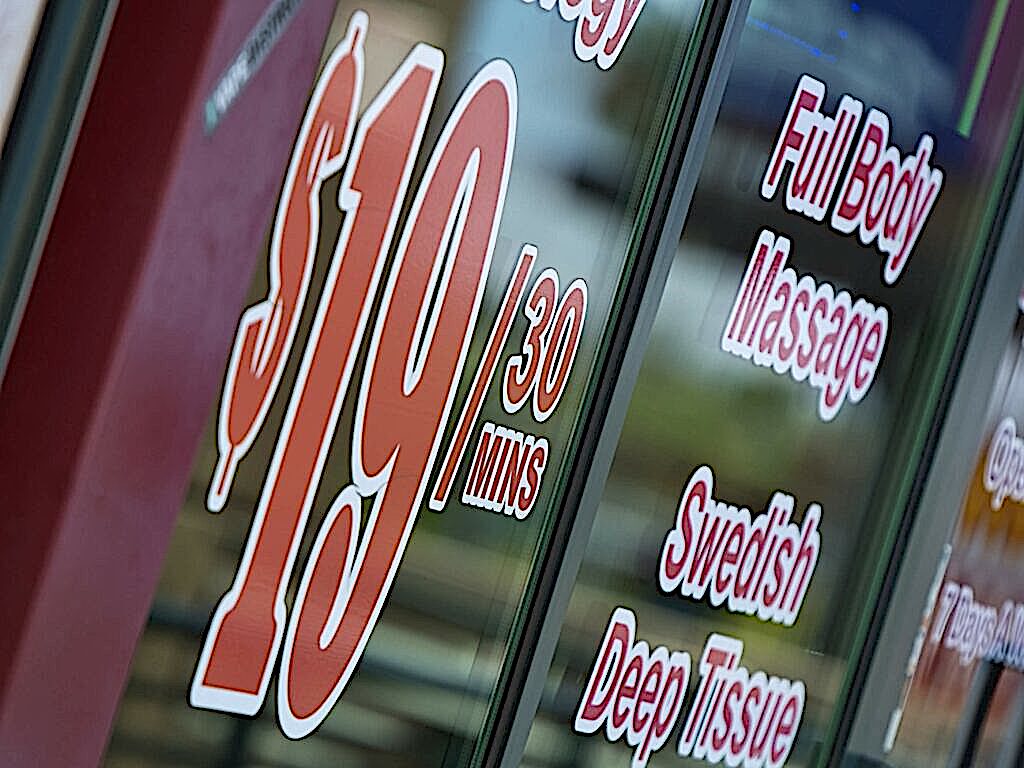 and David checked
into the Baccarat Hotel & Casino on the
Las Vegas Strip, jammed up against smaller,
squat casinos on each side where hawkers
stood outside shouting “FIRST DRINK FREE”
and proffering massage parlor cards with
pictures of young girls taken years before.
and David checked
into the Baccarat Hotel & Casino on the
Las Vegas Strip, jammed up against smaller,
squat casinos on each side where hawkers
stood outside shouting “FIRST DRINK FREE”
and proffering massage parlor cards with
pictures of young girls taken years before.
The Baccarat was a rehab of one of the older, neon-besotted casinos in the city, like the Sands, the Flamingo and the Tropicana. Katie and David had considered staying at the Mirage, but, after making contact with Steve Wynn, the hotel offered to comp them, which they could not accept. They had not yet been able to contact Harry Balaton, but hoped they could, if Steve Wynn put in a word for them—or if they told Balaton that Wynn had already been interviewed about his art collection.
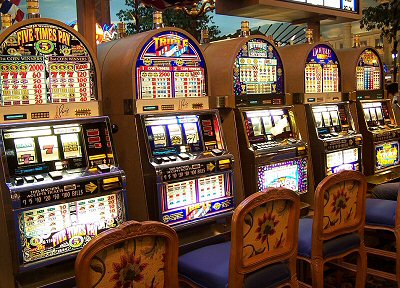 Their
meeting with Wynn was the next morning.
Katie and David walked through the
Baccarat, past dozens of craps and Keno
tables, blackjack counters, roulette
wheels, bingo tables and lanes of hundreds
of slots, amidst a cacophony of bells and
chuggings, the sound of coins falling into
the slots’ basins, yelps of instant
exaltation and groans of repeated loss. Cocktail
waitresses wandered by on high heels some
had not yet mastered on thick carpeting
while carrying trays of drinks. David took
a certain pleasure in pointing out which
guys on the floor were plainclothes
security.
“Know any place to eat around here?”
asked Katie. “I’m starving.”
Their
meeting with Wynn was the next morning.
Katie and David walked through the
Baccarat, past dozens of craps and Keno
tables, blackjack counters, roulette
wheels, bingo tables and lanes of hundreds
of slots, amidst a cacophony of bells and
chuggings, the sound of coins falling into
the slots’ basins, yelps of instant
exaltation and groans of repeated loss. Cocktail
waitresses wandered by on high heels some
had not yet mastered on thick carpeting
while carrying trays of drinks. David took
a certain pleasure in pointing out which
guys on the floor were plainclothes
security.
“Know any place to eat around here?”
asked Katie. “I’m starving.”
“The
food in the casinos is never any good. It’s
a little better to go outside and find a
steakhouse.
I wouldn’t touch any of the Italian
food out here with a ten-foot pole.”
“So, which one?”
“The Golden Steer goes back to the
’50s and is kind of fun. Big red leather
booths—one of them named ‘Sinatra’s’—and they claim to get a lot of celebrities, but
I think most of them date back to the days
when Bobby Darren was dating Sandra Dee.” (below)
they claim to get a lot of celebrities, but
I think most of them date back to the days
when Bobby Darren was dating Sandra Dee.” (below)
Katie said it sounded like fun. So, a half hour later she met David, who was wearing a blazer she’d seen a lot of.
She was wearing a black dress, whose hem stopped mid-thigh, and a string of pearls, her hair piled atop her head. As she approached David she put her arms up, twirled, and said, “Ta-dah!”
“Well, look at you, Sandra Dee. You look perfect. Maybe we should ask for Sinatra’s booth tonight.”
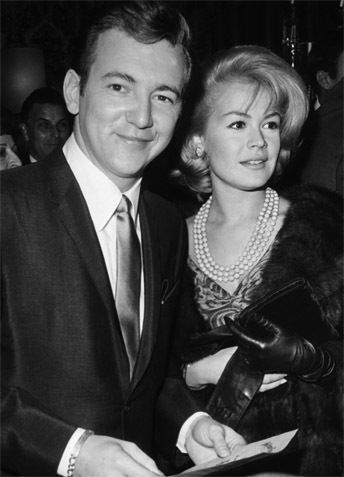 David
was so happy to be with Katie, looking as
she did, smelling lightly of a floral
perfume, with just a little more make-up
than she usually wore. In
heels, she was maybe a half-inch taller than
he was.
David
was so happy to be with Katie, looking as
she did, smelling lightly of a floral
perfume, with just a little more make-up
than she usually wore. In
heels, she was maybe a half-inch taller than
he was.
Katie didn’t really know much about Sandra Dee and couldn’t remember if she’d ever seen one of her movies, but she took the comparison as a high compliment from a man in his fifties who obviously thought Sandra Dee was pretty terrific. For her part, Katie was delighted to be dining with David again, remembering the adventure they’d had the year before along the Amalfi Coast and how she always felt she was in very good company if anyone got out of line. Which came in handy at The Golden Steer an hour later.
They
didn’t get the Sinatra
booth—it was reserved for
an NFL quarterback and his
party later that
night—but, because Katie
looked so beautiful, the
maître d’ “decorated” the
room by giving the couple
a very good booth nearby.
David slipped him
ten bucks.
As they were settling in,
three obviously drunk
revelers in their thirties
walked by their booth,
checking Katie out, one of
them giving a low whistle,
the others chuckling over
some off-color remark.
They walked on but
the whistler turned on his
heels, as if on a dance
stage, and strutted back,
putting his hands flat on
Katie and David’s table
and looking her straight
in the eyes, saying,
without glancing at David,
“Don’t mind me asking,
honey, but how’d you get
hooked up with grandpa
here?
You don’t look . .
. the type.”
David started to
rise from the table, but
Katie put her hand on his
wrist and said to the guy,
“No, but I am
the type to stick this
steak knife between your
fingers and count to five.
I’ve already had
one cocktail, so I don’t
know how good my aim is.
So I’d appreciate it if
you’d just leave.”
The guy turned to
David and said, “Well,
pretty girl don’t need
your help at all, does
she, grandpa?”
Katie’s glance
never varied and began the
children's challenge game
of quickly stabbing a
knife blade between their
fingers without looking.
The man did not flinch.
She was counting,
“. . . Two, three. . .”
The guy let out a
muffled scream as the
point of the knife just
grazed his ring finger.
“Jesus Christ, you
bitch, what the hell ya
think you’re doing?” he
yelled, wagging his hand
in the air as his friends
 looked
on.
looked
on.
At that point,
David’s hand came out from
under the table and came
down on the guy’s knuckles
and pressed them to the
table. A small dribble of
blood started to soak into
the cloth.
“You’re done here,
pal,” said David, “unless
you want me to fix it so
you’ll never throw craps
again.”
The guy was
gritting his teeth and
said, “Okay, okay, let
go!”
His two friends
started for the table but
before they could get
there two security men
from the restaurant—very
big men—arrived and asked
what the problem was.
The guy with the
bloody finger said, “No
problem, man, no problem.
Just cut my finger on the
knife. Lemme just wrap it
up in this napkin, and I’m
gone, okay?”
The security men
looked at Katie and David
and asked it they were all
right.
“Like the man said,
no problem,” David
replied.
“Good,” said one of
the security men. “I’ll
just escort this gentleman
over to our office and get
him a Band-Aid. And we’ll
have the waiter replace
your tablecloth and
napkins right away, sir.”
David said, “Good
idea, and use a strong
antiseptic. Thanks,
Donny.”
The security men
left, grabbing the drunk
by his arms and escorting
him away.
As two waiters
rushed to their table with
fresh linens, Katie looked
at David wryly and said,
“Gee, I thought I was
handling that pretty well,
not much blood.”
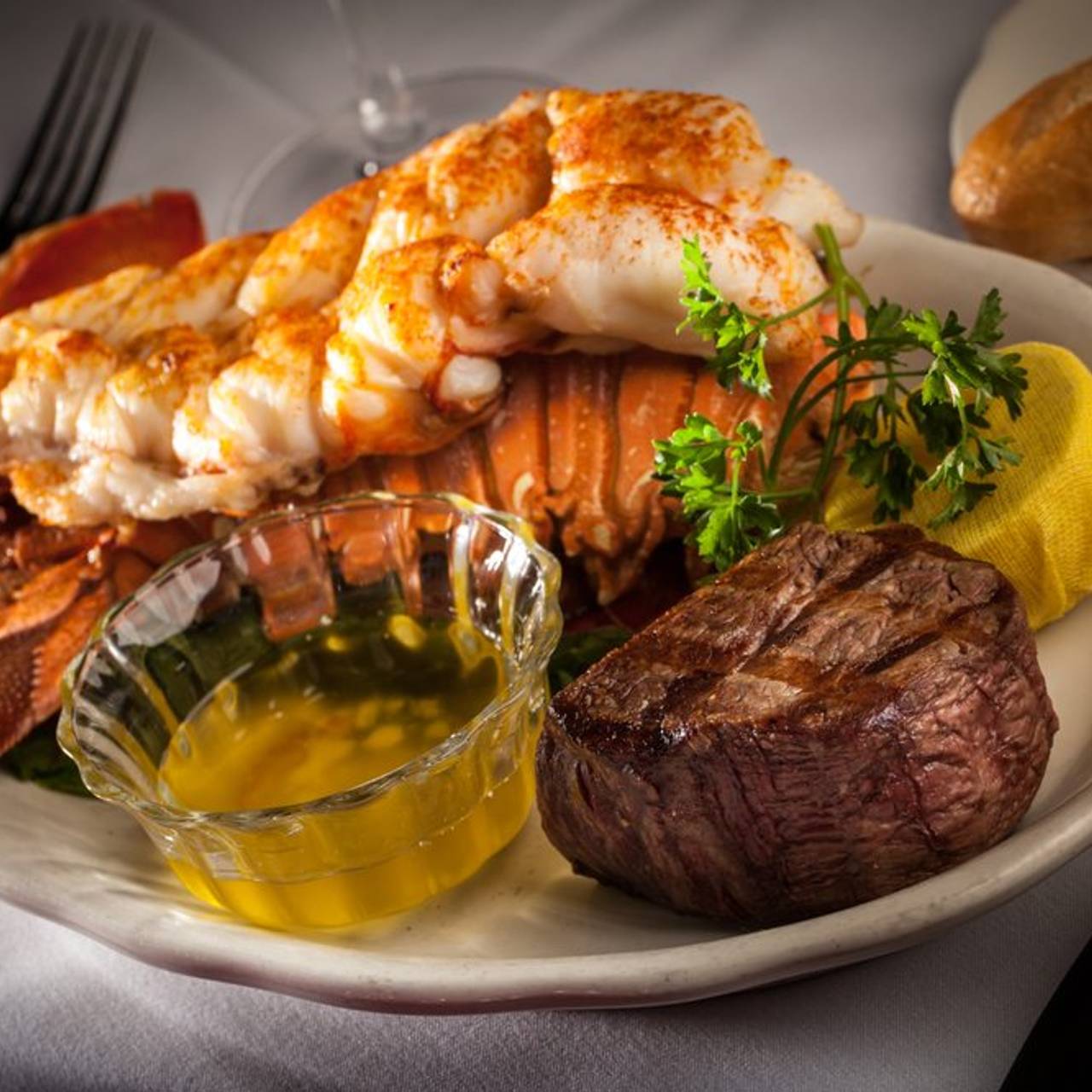 “I was
impressed,” said David, “but he was getting
a little . . . fresh, and I thought he
needed some persuasion to leave. Of
course, in the old days when I was still a
cop, I could have slugged him, or whipped
out my gun and pistol-whipped him, but, ah,
those days are long gone.”
“I was
impressed,” said David, “but he was getting
a little . . . fresh, and I thought he
needed some persuasion to leave. Of
course, in the old days when I was still a
cop, I could have slugged him, or whipped
out my gun and pistol-whipped him, but, ah,
those days are long gone.”
“Or maybe just shown him your badge?”
“That’s not as much fun.”
“By the way, you called the security
guy ‘Donny?’”
“Oh, yeah, he used to be a cop out
here I worked with on a couple of occasions.
Retired like me, now doing security work.”
“You know an awful lot of cops
everywhere, don’t you?”
“You put in twenty-five years on the
job and you meet a lot of people. Now,
shall we order?”
They ordered two shrimp cocktails and
the steaks were pretty good, they had to
admit, and they ordered a decent bottle of
wine from a mediocre, over-priced list. For
a moment they toyed with accepting the
waiter’s suggestion of having flaming
Cherries Jubilee, but Katie declined,
saying, “I’m not sure I want all these
people staring at us when the thing goes up
in flames.”
“Why not?” said David, “They’re all
going to go for it.”
Katie said she was tired, so they
paid the bill and went back to the hotel.
“Nightcap?” asked David.
“Only if there’s one I can wear on my
head in the room,” said Katie. “I’m really
knocked out, with the flight and the
cocktails and wine. I’ll
see you in the lobby. What, ten? Our
appointment with Wynn is at eleven.”
All David could
muster was, “Sure. See you then.
© John Mariani, 2016
❖❖❖
A Wide Array of New Red
Wines
at a
Wide Range of Prices
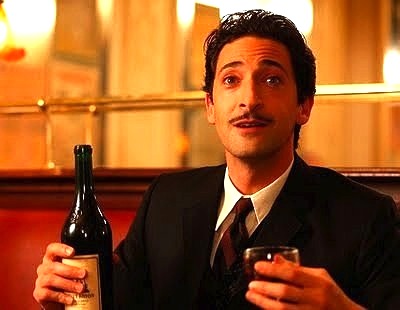
Two of my
favorite pastimes are to visit a local hardware
store or a wine shop—not an
overwhelming cavern like Home Depot,
or some wine-stocked warehouse, but smaller
venues where strolling through the aisles always reveals a new tool or a new wine I was
unaware I needed. In wine shops I
like to meet an owner who looks for unusual wines
and
good bargains that are not going to
be found among best-selling bottles. If one is a
regular,
the shop owner will be eager to show you those new bottlings he is enthusiastic about
within your budget. Here are some
I’ve found and enjoyed recently.
 Landmark Hop Kiln
Estate Reserve Pinot Noir 2018 ($85)—Founded in 1974 and
committed strongly to Chardonnay until 1995, when
they started making this Sonoma Valley Pinot Noir,
Landmark acquired the Hop Kiln estate in 2016, where
their best Pinot Noirs are now made. Its 14.2%
alcohol is admirable and shows the wine’s finesse,
while exhibiting the bold, fruity pleasure of Sonoma
Pinots.
Landmark Hop Kiln
Estate Reserve Pinot Noir 2018 ($85)—Founded in 1974 and
committed strongly to Chardonnay until 1995, when
they started making this Sonoma Valley Pinot Noir,
Landmark acquired the Hop Kiln estate in 2016, where
their best Pinot Noirs are now made. Its 14.2%
alcohol is admirable and shows the wine’s finesse,
while exhibiting the bold, fruity pleasure of Sonoma
Pinots.
La Valentina ‘Spelt’
Montepulciano d'Abruzzo Riserva 2018 ($23)—La Valentina is not
associated with another, better known, Abruzzese
producer named Valentino Valentini, and is a much
younger winery, showing off why the wines of this
eastern Italian region have attracted more and more
attention. "Spelt"
is named for a local wheat variety. The wine is 100%
Montepulciano and, while it doesn’t have the
off-putting tannins of lesser examples, it still has
an earthiness that matches up with grilled meats,
especially rabbit.
Alois Lageder
Schiava Alto Adige 2020 ($18)—Schiava is a red
varietal grown in Italy and Germany, where it is
called Trollinger or Vernatsch. It is really only
planted far north and is rarely high in alcohol.
Alois Lageder’s biodynamic issue is only 10%
alcohol, so it’s easy to drink with appetizers and
charcuterie, even a flavorful fish like salmon or
mullet.
Justin Justification
2018 ($65)—You’ve got to like
California Paso Robles blockbusters to appreciate this 15% alcohol
Bordeaux-style blend of 66% Cabernet Franc
and 34% Merlot, along the lines of Right Bank
Bordeaux producers. It was barrel-aged for 20
months in new French oak, and, though the tannins
are slightly tamed and the merlot gives it a
certain mellowness, I’d hang onto this big red for
another two to five years. Drink it now and do so
with something cooked over an open fire outside.
to appreciate this 15% alcohol
Bordeaux-style blend of 66% Cabernet Franc
and 34% Merlot, along the lines of Right Bank
Bordeaux producers. It was barrel-aged for 20
months in new French oak, and, though the tannins
are slightly tamed and the merlot gives it a
certain mellowness, I’d hang onto this big red for
another two to five years. Drink it now and do so
with something cooked over an open fire outside.
Blackbird
Vineyards Illustration 2017 ($135)—Unlike
Justification above, Illustration achieves
something of the same heft at only 14% alcohol, as
a proprietary blend of 49% Merlot, 28% Cabernet
Sauvignon and 23% Franc. Thus, the ballast of the
Cabernet Sauvignon underpins the Merlot, rather
than the other way around. It ain’t cheap, but it
really has a fine balance of fruits, acids and
tannins that have melded into an impressive Napa
Valley red.
 Tascante "Ghiaia Nera" Etna 2019 ($21)—The Tasca d'Almerita
family is now in its third century and eighth
generation with current scion Alberto Tasca. Tenuta
Tascante estate (a combo of Tasca and Etna) was
founded in 2007 with four parcels in the communes of
Castiglione di Sicilia and Randazzo, with a cool,
northern exposure. Ghiaia Nera (“black gravel'') is
made from the indigenous Nerello Mascalese grape,
known for its minerality from volcanic soil, which
makes it a good marriage with hearty Southern
Italian fare.
Tascante "Ghiaia Nera" Etna 2019 ($21)—The Tasca d'Almerita
family is now in its third century and eighth
generation with current scion Alberto Tasca. Tenuta
Tascante estate (a combo of Tasca and Etna) was
founded in 2007 with four parcels in the communes of
Castiglione di Sicilia and Randazzo, with a cool,
northern exposure. Ghiaia Nera (“black gravel'') is
made from the indigenous Nerello Mascalese grape,
known for its minerality from volcanic soil, which
makes it a good marriage with hearty Southern
Italian fare.
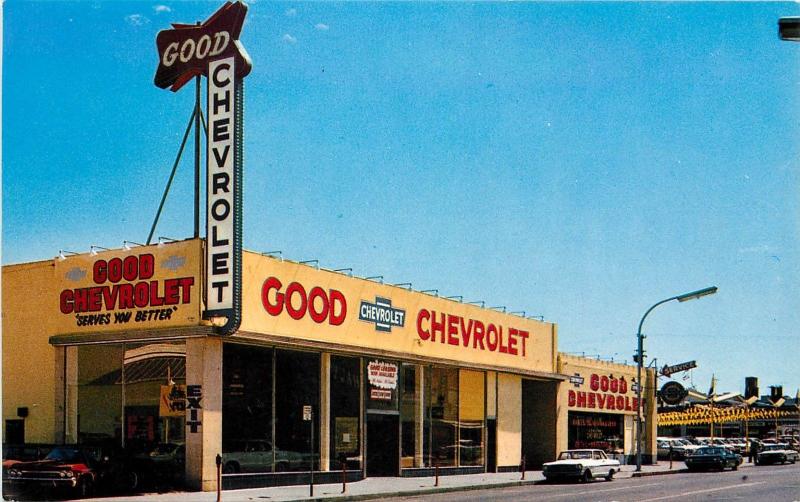
“Are
Restaurants in Car Showrooms the Future of Fine
Dining?”—By Joshua David
Stein, Esquire.com (1/31/22)
❖❖❖
Any of John Mariani's
books below may be ordered from amazon.com.
 The Hound in Heaven
(21st Century Lion Books) is a novella, and
for anyone who loves dogs, Christmas, romance,
inspiration, even the supernatural, I hope you'll find
this to be a treasured favorite. The story
concerns how, after a New England teacher, his wife and
their two daughters adopt a stray puppy found in their
barn in northern Maine, their lives seem full of promise.
But when tragedy strikes, their wonderful dog Lazarus and
the spirit of Christmas are the only things that may bring
his master back from the edge of despair.
The Hound in Heaven
(21st Century Lion Books) is a novella, and
for anyone who loves dogs, Christmas, romance,
inspiration, even the supernatural, I hope you'll find
this to be a treasured favorite. The story
concerns how, after a New England teacher, his wife and
their two daughters adopt a stray puppy found in their
barn in northern Maine, their lives seem full of promise.
But when tragedy strikes, their wonderful dog Lazarus and
the spirit of Christmas are the only things that may bring
his master back from the edge of despair. WATCH THE VIDEO!
“What a huge surprise turn this story took! I was completely stunned! I truly enjoyed this book and its message.” – Actress Ali MacGraw
“He had me at Page One. The amount of heart, human insight, soul searching, and deft literary strength that John Mariani pours into this airtight novella is vertigo-inducing. Perhaps ‘wow’ would be the best comment.” – James Dalessandro, author of Bohemian Heart and 1906.
“John Mariani’s Hound in Heaven starts with a well-painted portrayal of an American family, along with the requisite dog. A surprise event flips the action of the novel and captures us for a voyage leading to a hopeful and heart-warming message. A page turning, one sitting read, it’s the perfect antidote for the winter and promotion of holiday celebration.” – Ann Pearlman, author of The Christmas Cookie Club and A Gift for my Sister.
“John Mariani’s concise, achingly beautiful novella pulls a literary rabbit out of a hat – a mash-up of the cosmic and the intimate, the tragic and the heart-warming – a Christmas tale for all ages, and all faiths. Read it to your children, read it to yourself… but read it. Early and often. Highly recommended.” – Jay Bonansinga, New York Times bestselling author of Pinkerton’s War, The Sinking of The Eastland, and The Walking Dead: The Road To Woodbury.
“Amazing things happen when you open your heart to an animal. The Hound in Heaven delivers a powerful story of healing that is forged in the spiritual relationship between a man and his best friend. The book brings a message of hope that can enrich our images of family, love, and loss.” – Dr. Barbara Royal, author of The Royal Treatment.
 |
The Encyclopedia of American Food and Drink by John F. Mariani (Bloomsbury USA, $35) Modesty forbids me to praise my own new book, but let me proudly say that it is an extensive revision of the 4th edition that appeared more than a decade ago, before locavores, molecular cuisine, modernist cuisine, the Food Network and so much more, now included. Word origins have been completely updated, as have per capita consumption and production stats. Most important, for the first time since publication in the 1980s, the book includes more than 100 biographies of Americans who have changed the way we cook, eat and drink -- from Fannie Farmer and Julia Child to Robert Mondavi and Thomas Keller. "This book is amazing! It has entries for everything from `abalone' to `zwieback,' plus more than 500 recipes for classic American dishes and drinks."--Devra First, The Boston Globe. "Much needed in any kitchen library."--Bon Appetit. |
"Eating Italian will never be the same after reading John Mariani's entertaining and savory gastronomical history of the cuisine of Italy and how it won over appetites worldwide. . . . This book is such a tasteful narrative that it will literally make you hungry for Italian food and arouse your appetite for gastronomical history."--Don Oldenburg, USA Today. "Italian
restaurants--some good, some glitzy--far
outnumber their French rivals. Many of
these establishments are zestfully described
in How Italian Food Conquered the World, an
entertaining and fact-filled chronicle by
food-and-wine correspondent John F.
Mariani."--Aram Bakshian Jr., Wall Street
Journal.
"Equal parts
history, sociology, gastronomy, and just
plain fun, How Italian Food Conquered the
World tells the captivating and delicious
story of the (let's face it) everybody's
favorite cuisine with clarity, verve and
more than one surprise."--Colman Andrews,
editorial director of The Daily
Meal.com. "A fantastic and fascinating
read, covering everything from the influence
of Venice's spice trade to the impact of
Italian immigrants in America and the
evolution of alta cucina. This book will
serve as a terrific resource to anyone
interested in the real story of Italian
food."--Mary Ann Esposito, host of PBS-TV's
Ciao
Italia. "John Mariani has written the
definitive history of how Italians won their
way into our hearts, minds, and
stomachs. It's a story of pleasure over
pomp and taste over technique."--Danny Meyer,
owner of NYC restaurants Union Square
Cafe, The Modern, and Maialino.
|
 |
 |
 |
 |
 |
 |
 Everett Potter's Travel Report:
Everett Potter's Travel Report: 
 Eating Las
Vegas JOHN CURTAS has been covering
the Las Vegas food and restaurant scene
since 1995. He is the co-author of EATING LAS
VEGAS – The 50 Essential Restaurants (as
well as the author of the Eating Las
Vegas web site: www.eatinglasvegas.
He can also be seen every Friday morning as
the “resident foodie” for Wake Up With the
Wagners on KSNV TV (NBC) Channel 3 in
Las Vegas.
Eating Las
Vegas JOHN CURTAS has been covering
the Las Vegas food and restaurant scene
since 1995. He is the co-author of EATING LAS
VEGAS – The 50 Essential Restaurants (as
well as the author of the Eating Las
Vegas web site: www.eatinglasvegas.
He can also be seen every Friday morning as
the “resident foodie” for Wake Up With the
Wagners on KSNV TV (NBC) Channel 3 in
Las Vegas.
MARIANI'S VIRTUAL GOURMET
NEWSLETTER is published weekly. Publisher: John Mariani. Editor: Walter Bagley. Contributing Writers: Christopher
Mariani, Misha Mariani, John A. Curtas, Gerry Dawes, Geoff Kalish.
Contributing
Photographer: Galina Dargery. Technical
Advisor: Gerry
McLoughlin.
If you wish to subscribe to this
newsletter, please click here: http://www.johnmariani.com/subscribe/index.html
© copyright John Mariani 2022

